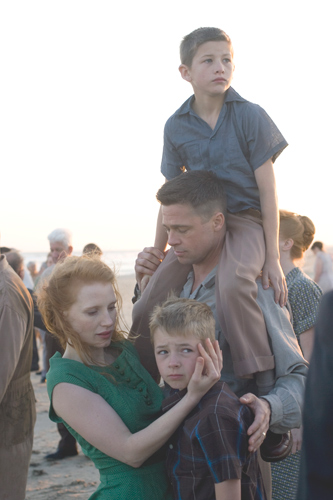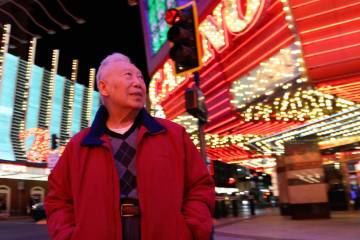‘Tree of Life’ spends too much time philosophizing rather than exploring character conflicts
When our family hit the road for vacation, you could count on certain rituals regardless of destination, from back-seat sing-alongs to surprise Dairy Queen stops.
Every time we visited a scenic wonder, my dad would whip out his trusty Bell & Howell movie camera (8 mm, thank you; no newfangled Super 8 for him) and shoot sweeping panoramas of awe-inspiring vistas while my mom, my sister and I waved dutifully for the camera.
When we gathered in the living room to watch newly developed footage of our travels, the same viewing pattern emerged: plenty of gorgeous scenery, with us puny humans pushed toward the edges of the frame, an afterthought amid the natural grandeur.
I thought of those home movies more than once while watching writer-director Terrence Malick's "The Tree of Life."
For many audiences, "The Tree of Life" will be a love-it-or-hate-it experience.
Such extremes accompanied its May premiere at the Cannes film festival. Some audience members booed after the initial screening -- and the festival jury ended up awarding the movie its top prize, the Palme d'Or.
While I'd never boo a movie as ambitious and visually resplendent as "The Tree of Life," I can't in good conscience lead the cheers.
Not for a movie that, to quote Woody Allen's felicitous "Annie Hall" phrase, achieves "total heaviosity." (P.S. For those of you who've never seen "Annie Hall" -- and why not? -- that's hardly a compliment.)
Of course, no one goes to a Terrence Malick movie expecting blazing, lightning-bolt action.
Malick is an arresting and evocative visual stylist, and his movies stand out for their stunning, overwhelming imagery -- and their often impressionistic depiction of nature. Think of World War II soldiers bloodying "The Thin Red Line's" lush paradise. Or British explorers invading pristine 17th-century Virginia in "The New World."
Just as my beloved dad did in our old home movies, however, "The Tree of Life" relegates its people to the periphery.
All too often, it's too busy contemplating the mysteries of the cosmos to bother with the characters at the heart (if it has one) of its total-heaviosity philosophizing.
"The Tree of Life's" central story, such as it is, takes place in 1950s Texas. (Hardly a coincidence for the Texas-raised, Austin-based filmmaker.)
As usual in Malick movies, there's a narrator -- an architect, recalling his childhood -- who explains that there are "two ways through life, the way of nature and the way of grace."
The way of nature, represented by the patriarch of the O'Brien family (an under-pressure Brad Pitt, effectively blending anger and frustration), "is willful; it only wants to please itself, to have its own way," the narrator informs us. And grace -- embodied by Mrs. O'Brien (an almost wordless yet endlessly expressive Jessica Chastain) -- "is smiling through all things," embodying the notion that "the only way to be happy is to love."
That conflict between husband and wife, father and mother, echoes in the upbringing of the family's three young sons (Hunter McCracken, Laramie Eppler, Tye Sheridan), who must endure their stern father's discipline, comforted -- to a point -- by the knowledge that their mother's quiet affection will soothe its sting.
Not enough to eliminate it, of course, which inspires a loss-of-innocence theme that haunts the narrator from boyhood to adulthood, when he grows up to become an architect -- who looks just like Sean Penn. (Don't be fooled by Penn's star billing; aside from handling the narration, his is strictly a supporting role.)
Most movies would focus on, and develop, the conflict between the authoritarian father and his restless, rebellious son. (We've seen plenty of them, from "East of Eden" to "The Great Santini," to name but two.)
Malick, however, isn't particularly interested in that conflict. He'd rather explore how (if not why) it fits into the greater scheme of things, widening the movie's focus to include roving dinosaurs, erupting volcanoes, rapidly dividing cells -- and animated visions of astrophysical phenomena that, thanks in part to veteran special effects consultant Douglas Trumbull, recall "2001: A Space Odyssey" a bit too closely for comfort. (Or maybe it's the classical musical works that augment Alexandre Desplat's soundtrack reveries.)
As visions go, they're undeniably and reliably spectacular. You would expect nothing less from Malick and multi-Oscar-nominated cinematographer Emmanuel Lubezki , who also shot Malick's "The New World."
But they're also more than a touch cold and distant. To say nothing of the fact that they're not nearly as profound as Malick seems to think.
Anyone who's ever seen Thornton Wilder's "Our Town" -- a good version, anyway -- knows how profound and moving the poetry of simple human life can be.
But in "Our Town," the point is the people who live in Grover's Corners, not Grover's Corners itself.
Alas, "The Tree of Life" seems far more interested in exploring the tree than the lives of the people going on beneath its expansive branches.
Contact movie critic Carol Cling at ccling@reviewjournal.com or 702-383-0272.
Review
"The Tree of Life"
138 minutes
PG-13; profanity, violence
Grade: C+
at Village Square
Deja View
A genuine maverick, Terrence Malick has been making movies since the 1970s -- and "The Tree of Life" is only his fifth feature credit as director. Here are the other four:
"Badlands" (1973) -- Malick's stunning feature debut, inspired by the real-life 1958 killing spree of Charles Starkweather and Caril -Ann Fugate, follows a young garbage collector (Martin Sheen) and his girlfriend (Sissy Spacek), on the run from South Dakota to Montana, as they leave a seemingly random trail of dead bodies behind them.
"Days of Heaven" (1978) -- Malick's haunting, visually resplendent drama, set in turn-of-the-20th-century Texas, focuses on a young couple (Richard Gere, Brooke Adams), posing as brother and sister, who find work with a prosperous farmer (Sam Shepard), setting a fateful romantic triangle in motion.
"The Thin Red Line" (1998) -- James Jones' autobiographical novel, about the World War II battle of Guadalcanal, inspires this impressionistic adaptation featuring Nick Nolte, Jim Caviezel, John Cusack and "Tree of Life" co-star Sean Penn.
"The New World" (2005) -- Malick brings new and vivid life to the familiar tale of Indian princess Pocahontas (Q'orianka Kilcher) and John Smith (Colin Farrell), exploring the clash between American Indians and English explorers in 17th-century Virginia; Christian Bale and Christopher Plummer co-star.
-- By CAROL CLING






















